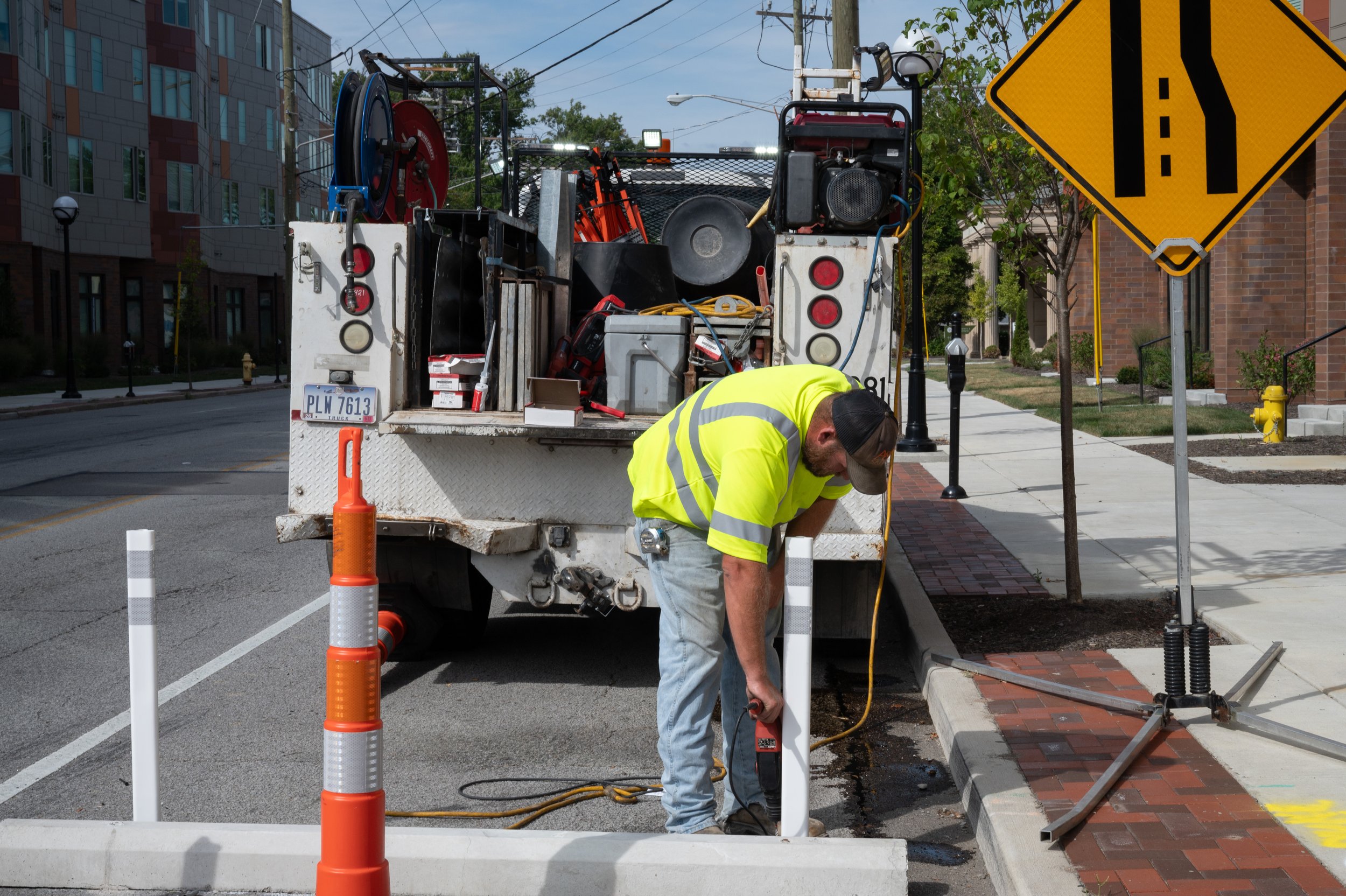The Problem
Just after midnight on December 2021, on a cold, clear morning, 37-year-old James Towns was biking home from his job at Meijer, pedaling down North Bend Road in northwest Cincinnati. Just after he passed Edwood Avenue heading west, Towns was hit by a driver, who fled the scene. Towns died at a hospital soon after. As his family and friends grieved his death, local media reported that there had been six crashes in five months on the same block of North Bend Road where Towns had died.
Residents of College Hill, a mixed-race, middle-class neighborhood in northwest Cincinnati, were fed up with the seemingly unending traffic violence unfolding outside their front doors. Since 2020, 33 people have been killed or seriously injured in College Hill. Over the past three years, there have been 45 crashes every month, an average of 1.5 crashes every day. And crashes were becoming more frequent and more deadly. In 2022 alone, 15 people were killed or seriously injured on streets in College Hill.
Neighbors like Wayne West, who lives on North Bend Road steps from where Towns was killed, were growing increasingly concerned about the number of crashes they witnessed from their front porches. “I lost hope,” he says. Many people didn’t walk on the sidewalks or linger in their front yards for fear of being hit.
“It was hectic. Very hectic,” says Steven Moore, who works as a crossing guard at Pleasant Hill Academy on North Bend Road near Edwood Avenue. “It was a hazard. A series of hazards waiting for somebody to make a serious mistake. Folks go through that area too fast. They’re not paying attention. Everybody’s in a hurry to get nowhere.”
Noah Heibisen was born and raised in College Hill. He lives with his wife and children just west of Hamilton Avenue, a four-lane road that cuts through the neighborhood north to south. Heibisen, who uses a wheelchair, and his family often strolled down to the restaurants on Hamilton Avenue just south of North Bend Road, the center of College Hill’s business district. But they would take back streets to avoid Hamilton Avenue. On the busy thoroughfare, “cars would be going past us at exorbitant speeds, and only inches away from us,” he says. “It was terrifying. You didn’t really want to walk the kids, your family up to the shops. You tried to avoid it as much as possible.”
Shortly after Towns was killed, two College Hill residents started talking about the crashes that plagued their neighborhood. Felicia Eschenlohr had lived on North Bend Road for 26 years and watched as traffic violence had gotten increasingly worse. “Everybody was complaining about all of the accidents—cars up in people’s front yards, people’s fences knocked over, the whole nine yards,” she says. Her neighbor, Julie Brown, had long been involved in pedestrian safety campaigns, including petitioning for speed bumps on her small residential street a decade earlier. “We were like, this is ridiculous,” Eschenlohr says. “We’ve got to do something.”
They were members of the College Hill Forum, the community council for the neighborhood. They started a group called the College Hill Traffic and Pedestrian Safety Project and began hosting weekly Zoom calls. After talking to numerous city transportation officials about the traffic violence in their neighborhood, they applied for a grant from the Devou Good Foundation. They wanted help building safer streets in their neighborhood.
The Solution
Jody Robinson and Matt Butler of the Devou Good Foundation reached out to Eschenlohr and Brown soon after receiving their application. “This was a community that was impacted by traffic violence pretty significantly and a community that also was trying to advocate for themselves,” Butler says. In February 2022, Devou Good awarded the College Hill neighborhood an active transportation grant to improve safety by implementing traffic calming measures. Traffic calming projects use physical design changes to the street to encourage drivers to slow down. Research shows that these low-cost changes reliably reduce vehicle speeds and improve safety for pedestrians and cyclists.
Vehicle speed affects both the risk of a crash and how likely someone is to be killed or seriously injured when hit. Pedestrians who are struck by drivers traveling at 48 miles an hour face a staggering 90 percent likelihood of a fatal outcome. At 33 miles per hour, the likelihood of death falls to 50 percent. Traffic counts on Hamilton Avenue had shown that 60 percent of drivers exceeded the posted speed limit of 35 miles an hour.
Working with Cincinnati’s Department of Transportation & Engineering and neighborhood representatives, Devou Good Foundation proposed a Complete Streets design, focusing on North Bend Road between Simpson and Hempwood Avenues and Hamilton Avenue from North Bend Road to Hollywood Avenue. After consulting with College Hill residents and city engineers, Devou Good Foundation proposed a road diet that would consist of narrowing the street from four to two car lanes to calm traffic and reduce speeds. The project would replace one lane of traffic with a parking lane—reducing speeds by visually narrowing the street—and the other with a protected two-way bicycle lane, expanding access for all users. The project would also install a hardened centerline at the intersection of Hamilton Avenue and North Bend Road, which would require drivers to make slower, squarer left-hand turns, reducing conflicts between left-turning vehicles and pedestrians.
Devou Good Foundation presented its proposed designs to the College Hill Forum in February 2023. The project would be constructed with interim materials intended to last for five to seven years, providing the flexibility to test and improve the proposed safety interventions.
Construction began in August 2023. On the north side of North Bend Road, the traffic lane was replaced by a two-way bicycle lane, separated from traffic using concrete wheel blocks and fiberglass delineators. On the south side of the street, the traffic lane was transformed into an on-street parking lane, protected with curb extensions comprised of concrete wheel blocks and plastic delineators. On Hamilton Avenue north of North Bend Road, protected parking was installed on both sides of the street, reducing the number of drive lanes from four to two. At the intersection of North Bend Road and Hamilton Avenue, crews added small rubber barriers in the middle of crosswalks to direct turning traffic.
The Result
Devou Good Foundation collected data in collaboration with the community to track speeds on North Bend Road and Hamilton Avenue before and after the project was installed. Most drivers were minimally impacted: Average speeds dropped from 34 miles per hour to 30 miles per hour. But reckless speeding—drivers traveling above 50 miles an hour, those most likely to seriously injure or kill cyclists and pedestrians—dropped by 90 percent. Devou Good Foundation surveyed College Hill residents about the project and 80 percent said the new street design had reduced speeding.
Importantly, the two-lane design reduced the number of crashes and the severity of crashes in the project area. Since the project was implemented, there’s been a 76 percent reduction in injuries and a 100 percent reduction in serious injuries and deaths. During five-month span in 2022, there were 43 crashes, 21 injuries, and two serious injuries in the project area. During the same five-month span in 2023, after the project’s completion, there were 31 crashes, five injuries—and no serious injuries or deaths. And the economic cost of those crashes reduced tenfold, justifying the $500,000 project investment within the first two weeks.
The two-lane road diet on North Bend Road and Hamilton Avenue was more effective in reducing crashes, serious injuries, and deaths than a similar three-lane road diet on Glenway Avenue. In 2023, Cincinnati’s Department of Transportation & Engineering reduced the total number of lanes on a two-mile stretch of Glenway between Birch Avenue and Shirley Place from four total lanes to three, comprising two drive lanes plus a center turn lane. Preliminary data shows that the road diet resulted in a 55 percent reduction in injuries and a 50 percent reduction in serious injuries, as drivers continued to speed and some used the center turn lane as a passing lane. Two people have died on the road since the project’s completion. Recently, the city has added three sets of speed cushions along the project area on Glenway. The speed cushions are designed to slow drivers in areas of high conflict. Reports of drivers recklessly using the center turn lane for passing continue.
In College Hill, Noah Heibisen and his wife now feel comfortable using Hamilton Avenue to access restaurants and shops. “It is absolutely wonderful,” he says. “It is a very nice buffer to be able to walk up to the avenue and back. I’ve noticed reduced speeds overall and I just feel more comfortable.”
“I think it’s made College Hill a much more usable, walkable, calmer, nicer neighborhood,” he says.
Steven Moore agrees. “Changing the traffic pattern there … has worked out very tremendously,” he says. He feels “much, much safer” crossing the street. “My job is to get a child safely from one side of street to the next,” he says. Now, his job is a whole lot easier.
On a rainy day in November 2023, several dozen community members and elected officials gathered under two canopy tents to celebrate the official opening of the College Hill Transportation Safety project. “Do we value human life, or do we value speed?” asked city council member Mark Jeffreys. “This is about building communities where people connect and prioritizing human life over speed … This is about prioritizing people who live here, and not just people passing through.”
At the end of the event, Felicia Eschenlohr and Julie Brown held a ribbon across the brand-new protected bike lane and a group of cyclists—led by a parent on a cargo bike with his two young daughters in tow—broke through the ribbon and pedaled down the street.







